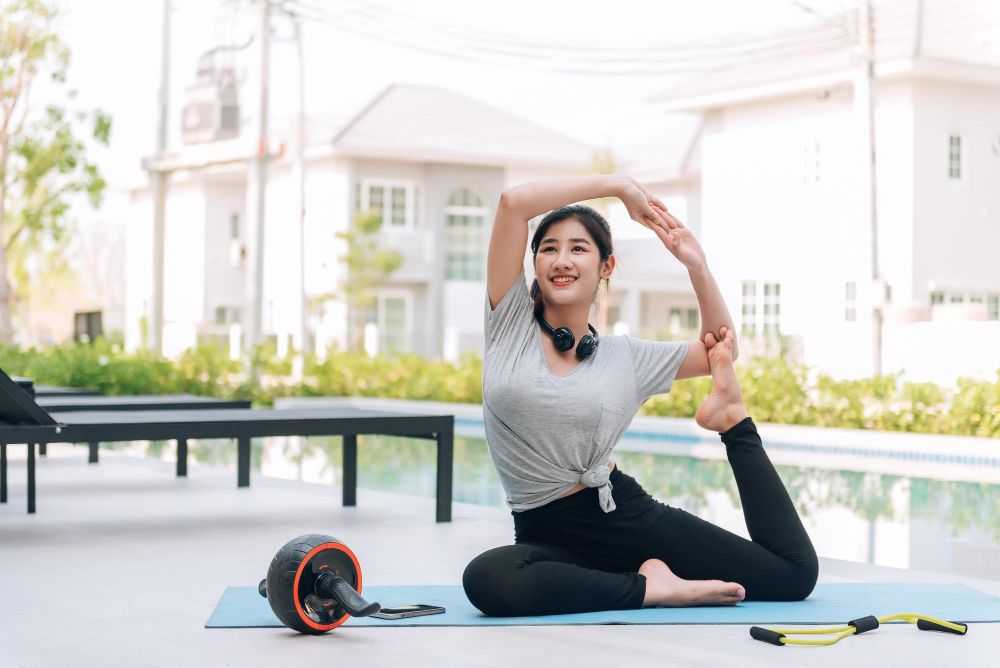Feeling overwhelmed by the constant hustle and bustle of daily life? You’re not alone. In today’s fast-paced world, stress has become an unwelcome companion for many of us. But what if there was a natural, accessible way to find calm amidst the chaos? 🧘♀️✨
Enter yoga – an ancient practice that’s stood the test of time for good reason. More than just trendy poses and stylish leggings, yoga offers a powerful toolkit for managing stress and finding inner peace. From soothing stretches that melt away tension to breathing techniques that calm your racing mind, yoga provides a holistic approach to stress relief that’s both effective and enjoyable.
In this blog post, we’ll explore how yoga can be your secret weapon against stress. We’ll dive into the science behind stress and its effects on your body and mind, introduce you to key yoga poses that target tension, reveal breathing techniques to help you unwind, and show you how to incorporate meditation into your practice for ultimate relaxation. Get ready to transform your relationship with stress and discover a more balanced, peaceful you!
Understanding Stress and Its Impact
Physical effects of stress on the body
Chronic stress can wreak havoc on our physical well-being, affecting multiple systems in the body. Here are some of the most common physical effects of stress:
- Muscle tension and pain
- Headaches and migraines
- Digestive issues (e.g., upset stomach, diarrhea, constipation)
- Weakened immune system
- Increased blood pressure and heart rate
- Sleep disturbances
The following table illustrates how stress impacts different body systems:
| Body System | Stress-Related Effects |
|---|---|
| Cardiovascular | Increased heart rate, high blood pressure |
| Digestive | Acid reflux, ulcers, irritable bowel syndrome |
| Respiratory | Rapid breathing, asthma exacerbation |
| Musculoskeletal | Tension headaches, back pain, jaw clenching |
| Endocrine | Hormonal imbalances, increased cortisol production |
Mental and emotional consequences of chronic stress
Prolonged exposure to stress can significantly impact our mental and emotional well-being. Some common consequences include:
- Anxiety and depression
- Mood swings and irritability
- Difficulty concentrating and making decisions
- Memory problems
- Feeling overwhelmed or out of control
The role of yoga in stress management
Yoga offers a holistic approach to stress relief, addressing both the physical and mental aspects of stress. By combining physical postures, breathing exercises, and meditation, yoga can:
- Reduce muscle tension and promote relaxation
- Lower cortisol levels, the primary stress hormone
- Improve sleep quality and duration
- Enhance mindfulness and present-moment awareness
- Boost mood and emotional regulation
Regular yoga practice can help build resilience to stress, enabling individuals to cope more effectively with life’s challenges. As we explore specific yoga poses and techniques in the following sections, you’ll discover powerful tools for managing stress and promoting overall well-being.
Key Yoga Poses for Stress Relief
Child’s Pose for calming the mind
Child’s Pose, or Balasana, is a gentle yoga posture that offers immediate stress relief. This pose allows you to turn inward, quieting the mind and releasing tension throughout the body.
Benefits:
- Calms the nervous system
- Releases back and neck tension
- Promotes relaxation and inner focus
How to perform:
- Kneel on the floor with toes together and knees hip-width apart
- Sit back on your heels and fold forward, extending arms in front
- Rest your forehead on the mat and breathe deeply
Cat-Cow Stretch for releasing tension
The Cat-Cow Stretch, combining Marjaryasana and Bitilasana, is excellent for releasing tension in the spine and core muscles.
Benefits:
- Improves spinal flexibility
- Relieves back and neck tension
- Stimulates abdominal organs
How to perform:
- Start on hands and knees in a tabletop position
- Inhale, drop belly, lift chest and tailbone (Cow)
- Exhale, round spine, tuck chin to chest (Cat)
- Repeat for 5-10 breath cycles
Standing Forward Bend for relaxation
The Standing Forward Bend, or Uttanasana, is a simple yet effective pose for stress relief.
Benefits:
- Calms the mind and relieves anxiety
- Stretches hamstrings and lower back
- Improves blood flow to the brain
How to perform:
- Stand with feet hip-width apart
- Exhale and fold forward from the hips
- Let head and arms hang loose
- Hold for 30 seconds to 1 minute
Legs-Up-the-Wall Pose for anxiety reduction
Legs-Up-the-Wall, or Viparita Karani, is a restorative pose that can significantly reduce anxiety and promote relaxation.
Benefits:
- Reduces anxiety and stress
- Relieves tired legs and feet
- Improves circulation
How to perform:
- Sit close to a wall and lie back
- Swing legs up against the wall
- Rest arms by your sides, palms up
- Hold for 5-15 minutes
| Pose | Primary Benefit | Duration |
|---|---|---|
| Child’s Pose | Calming the mind | 1-3 minutes |
| Cat-Cow Stretch | Releasing spinal tension | 5-10 breath cycles |
| Standing Forward Bend | Full-body relaxation | 30-60 seconds |
| Legs-Up-the-Wall | Anxiety reduction | 5-15 minutes |
Now that we’ve explored these key yoga poses for stress relief, let’s move on to some powerful breathing techniques that can further enhance your relaxation practice.
Breathing Techniques to Reduce Stress
Deep Belly Breathing for instant calm
Deep belly breathing, also known as diaphragmatic breathing, is a powerful technique for immediate stress relief. This practice involves breathing deeply into your abdomen rather than shallowly into your chest. Here’s how to perform deep belly breathing:
- Sit or lie comfortably
- Place one hand on your chest and the other on your belly
- Inhale slowly through your nose, feeling your belly expand
- Exhale slowly through your mouth, feeling your belly contract
| Benefits of Deep Belly Breathing |
|---|
| Reduces stress hormones |
| Lowers heart rate |
| Improves oxygen flow |
| Increases relaxation |
Alternate Nostril Breathing for balance
Alternate nostril breathing, or Nadi Shodhana, is a yogic breathing technique that helps balance the left and right hemispheres of the brain, promoting a sense of calm and equilibrium. Follow these steps:
- Sit comfortably with your spine straight
- Use your right thumb to close your right nostril
- Inhale deeply through your left nostril
- Close your left nostril with your ring finger
- Open and exhale through your right nostril
- Inhale through the right nostril
- Repeat the cycle, alternating nostrils
4-7-8 Breathing for better sleep
The 4-7-8 breathing technique, developed by Dr. Andrew Weil, is particularly effective for promoting relaxation and improving sleep quality. This method involves inhaling for 4 counts, holding the breath for 7 counts, and exhaling for 8 counts. Here’s how to practice:
- Sit with your back straight
- Place the tip of your tongue behind your upper front teeth
- Exhale completely through your mouth
- Close your mouth and inhale through your nose for 4 counts
- Hold your breath for 7 counts
- Exhale completely through your mouth for 8 counts
- Repeat the cycle 3-4 times
With these breathing techniques in your stress-relief toolkit, you’ll be better equipped to manage stress and promote relaxation in your daily life. Next, we’ll explore how incorporating meditation into your yoga practice can further enhance your stress-reduction efforts.
Incorporating yoga into your daily routine can be a powerful tool for managing stress and promoting overall well-being. By practicing stress-relieving poses, focusing on breath work, and incorporating meditation, you can create a holistic approach to combating the negative effects of stress on your mind and body.
Remember, consistency is key when it comes to reaping the benefits of yoga for stress relief. Start with just a few minutes each day and gradually increase your practice as you become more comfortable. By making yoga a regular part of your life, you’ll be better equipped to handle life’s challenges and maintain a sense of calm and balance in your daily activities.



